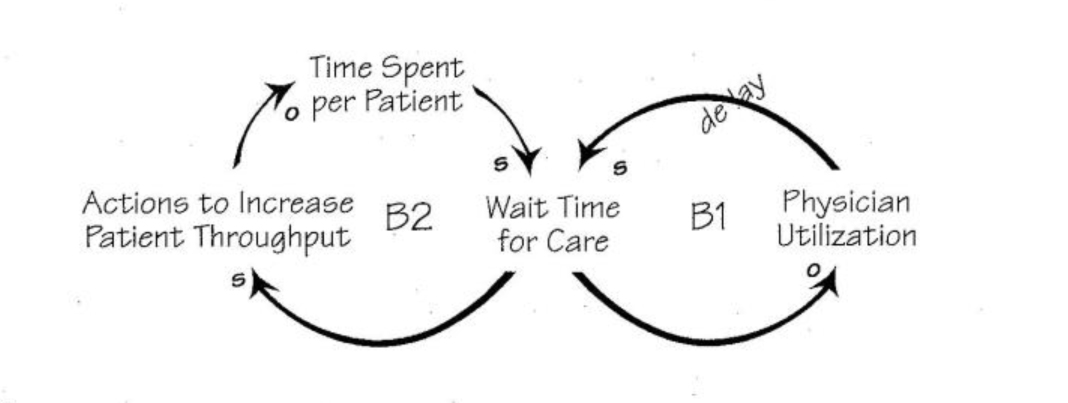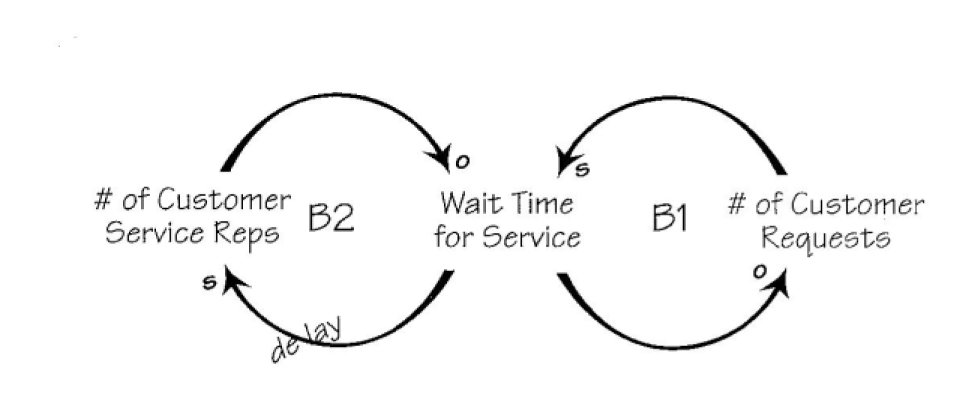Using a systems thinking approach can expand our understanding of a particular problem or issue by helping us view our actions in the context of the larger system. We often fail to anticipate the entire series of cause-and-effect relationships that will follow from a particular decision. As a result, when something happens in the “external” world (such as a drop in orders, price pressure, or increased customer complaints), we do not recognize how our own actions contributed to that outcome.
One set of loops that can help us better understand the basic interactions between a company and its marketplace is the supply/demand structure. Most everyone is familiar with the basic law of supply and demand: if demand rises, price tends to go up (all else remaining the same), and conversely, as supply goes down, price tends to go up (again, all else remaining equal). From a systems thinking perspective, this dynamic can be simply described by two coupled balancing loops that attempt to stabilize around a particular variable—in this case, price.
Generic Structure

The generic supply/demand structure can be used to describe any situation in which the ability to supply a good or service is being balanced with the demand, utilization, or consumption of that product or service.
Supply and Demand: A Generic View
If we look at the supply/demand structure from a more generic perspective, we can use it to describe any situation in which an ability to supply a good or service is being balanced with the demand, utilization, or consumption of that product or service. This structure acts like a see-saw, with supply on one side, demand on the other, and some pivot point in the middle (such as quality, price, availability, or service) that links the consumer actions and the company’s decisions (see “Balancing Loops with Delays: Teeter-Tottering on See-Saws,” June/July 1990). The central variable serves as the “adjusting variable” because it is the signal that causes players on both sides of the see-saw to adjust the imbalance between supply and demand (see “Generic Structure”). These dynamics can occur between the company and the market-place or within an organization, where an internal function or unit (such as training or l.S.) is supplying services to other parts of the company.
For example, in the medical industry, one common adjusting process revolves around waiting time to get an appointment with a physician. On the demand side, if the wait time to see a particular physician becomes too long, patients might either try to find another provider, put off receiving care (in the hopes that the problem will “take care of itself”), or, if the problem is serious enough, go to the emergency room. If enough patients find alternate solutions, this leads to a decline in the physician’s utilization rate, which then eases the pressure on the physician’s schedule so that the wait time is reduced (B1 in “Medical Supply/Demand,” page 8). Physicians, for their part, might try to reduce the wait time for care by processing patients faster, adding physicians to their practice, or asking ancillary staff (such as nurse practitioners) to play a more significant role in patient care. All of these actions would increase the patient capacity and reduce the wait (B2).
What is important to note is that both balancing actions are usually happening simultaneously—that is, at the same time that the physicians are looking for ways to ease the patient bottle-neck, the patients are already taking action to relieve that pressure by seeking alternate providers or finding other ways to take care of themselves. Because demand is falling at the same time that capacity is rising, these actions will create another imbalance this time, with more available capacity for seeing patients than the actual demand for appointments. When this occurs, both parties will once again take action to close the gap (patients will return to their original provider because of the reduced wait time, while the physician’s practice might ease scheduling pressure) and the see-saw invariably tips in the other direction.
Seeking a Balance
This same see-saw structure of balancing capacity and demand shows up in a variety of contexts, such as service quality (hospitals, banks, car-rental shops, fast-food restaurants, I.S., training) or product availability (retail stores, specialty products, manufacturers).
Of course, most companies would like to find a way to strike exactly the right balance between the demand in the marketplace and their ability to service that demand. Unfortunately, that rarely happens. As the medical example shows, what is more likely is a pattern of oscillation as the two sides overshoot each other, adjust, and overshoot again.
In part, this behavior occurs because of several significant delays in the system: customer perception delay, company perception delay, and capacity addition delay.
- Customer Perception. It takes time for word to get around that a company cannot provide a particular product or service (this signal usually comes in the form pf rising prices, lengthening delivery delays, or declining quality). It also takes time for people to alter their usage or consumption patterns. Similarly, once a company has added capacity, it takes time for that signal to make it into the marketplace and draw customers back.
- Company Perception. Just as it takes time for customers to realize that a company can no longer meet their needs, it takes time for the company to recognize that demand for its product or service is declining. This delay is often exacerbated because companies do not act upon the information immediately, believing that the drop off in demand is either temporary or due to factors other than capacity shortfall.
- Capacity Additions. Once the company has recognized the imbalance between the marketplace demand and its ability to meet that demand, there is a further delay while the company adds the needed capacity. The length of this delay depends on the nature of the capacity being added—for example, it takes a lot longer to add capital equipment than to increase customer service representatives or improve a process.
Medical Supply/Demand

In the medical industry, a common adjusting factor is the wait time for seeing a doctor. On the demand side, if the wait time becomes too long, patients will seek alternatives (e.g., other doctors, self-medication, etc.), leading to a decline In physician utilization (B1). On the supply side, the wait can be reduced by asking physicians to spend less time per patient, thereby increasing their patient capacity (B2).
Using the Structure
The generic supply/demand causal loop structure provides a useful starting point for exploring how internal actions and marketplace decisions are intertwined. To see how the structure can be applied to a specific problem, let’s take a look at the example of ZSearch, a research company that specializes in tracking down research articles in the biochemical industry. ZSearch had built its reputation on the quality and timeliness of its response to its customers’ inquiries. However, the company’s managers have become concerned about two recent trends: customer surveys have ranked the company below its competitors in terms of customer service, and they have noticed a drop-off in the overall number of research requests per day.
1. Define the Variables. To begin mapping out the system, first define the different parts of the see-saw: what is being “supplied,” what is being “demanded,” and what is the fulcrum around which the imbalances between the two are resolved.
In ZSearch’s case, the “supply” would be the number of customer service representatives, the “demand” would be the number of requests from customers, and the “fulcrum” would be the wait time for service. If the number of requests coming in outstrips the available capacity, an imbalance appears in the system. Customers who are stuck on the phone waiting for a customer service rep might be inclined to hang up and call one of ZSearch’s competitors, thus decreasing the wait time for service (B1 in “ZSearch’s Balancing Act”). On the other side of the see-saw, once ZSearch gets the signal that it needs more capacity, it can respond by increasing the number of service reps or raking other actions that would likewise decrease wait time (B2).
2. Identify Delays. Once you have identified the fundamental balancing loops, it is important to identify and quantify the relevant delays. In ZSearch’s case, the customer perception delay may be fairly short—it doesn’t take lung for customers to get a busy signal, put down the phone, and call a competitor (although it does take time to establish new supplier relationships).
On ZSearch’s side, there might be a long perceptual delay before ZSearch identifies the source of the drop-off in call volume and how to respond to it. At this point, it would be easy for them to blame external forces, such as aggressive competitors, rather think examining how their own policies might be contributing to the decline. However, ZSearch’s managers felt that the problem might stem from a shortage of trained service reps. They knew they could case this burden in the short term by increasing the work hours of their current staff, though they acknowledged that it would take several months to hire and train the new reps.
3. Design Interventions. When considering any potential solution, it is important Lu evaluate the action in terms of both its internal consequences and its impact on the marketplace. In particular, look for ways you can more directly influence the customers’ behavior (the demand loop), rather than simply reacting after-the-fact (the supply loop).
At first, ZSearch’s managers were at a loss as to how they could have any direct influence on their customer’s decision to hang up and call a competitor. But after some thought, they came up with with a program that they called the “superior customer service guarantee.” They promised that any customer who waited longer than 60 seconds for an available representative would receive a 40% discount on the order. It was a costly gamble, but it paid off—the guarantee not only boosted ZSearch’s reputation in the field, bur on three occasions that the demand outstripped capacity, customers were willing to wait the extra time (to get the discount) and ZSearch retained the sale.
More importantly, ZSearch received timely, valuable feedback about their response time without risking losing customers. Knowing that they now had a strong system in place for tracking their call volume and service turnaround (the demand side of the diagram), they could focus their attention on the supply side of the diagram—finding ways to keep their staffing up to optimal levels.
Larger Implications
Many organizational “crises”—poor sales, quality problems, slipping delivery times–can be traced back to the mismatch between supply and demand and how this disequilibrium is corrected. Within organizations, this plays out in pressures to outsource in order to improve service or reduce costs. But it also occurs in whole industries, as poor service or high prices attract new competitors and innovators to the industry. This is the very mechanism by which customers see quality rise as prices decline over rime in an industry.
Michael Goodman is vice president of Innovation Associates, Inc. (Waltham MA) and heads IA’s Systems Thinking Group.
Colleen Lannon Is co-founder of Pegasus Communications and managing editor of The Systems Thinker•.
Balancing Act

If the number of incoming requests outstrips capacity, an imbalance appears. This imbalance can be resolved in one of two ways: (1) customer calls drop off due to the long wait (B1); or (2) customer service reps are added in order to reduce the time it takes to process requests (B2).
